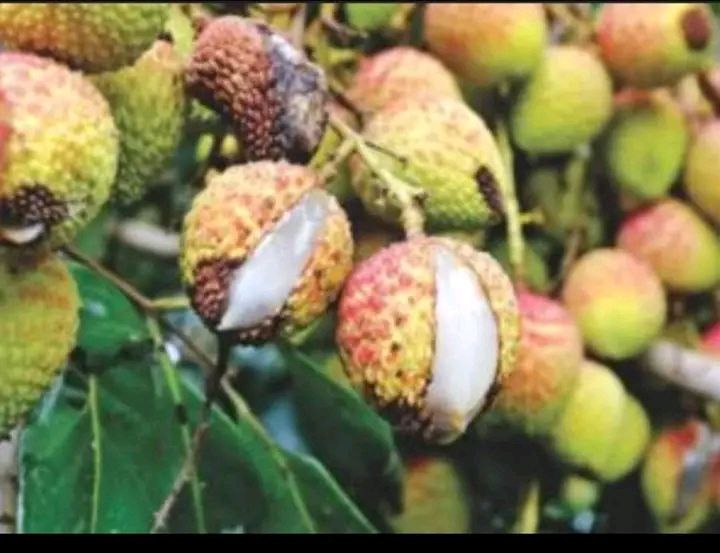Fruit cracking in litchi (Litchi chinensis) is a serious problem that affects the quality and marketability of the fruit. It can lead to considerable economic losses. It is a physiological disorder and caused due to abrupt change in atmospheric temperature, Relative Humidity, soil moisture condition, varietal characters, and micro-nutrients deficiency. Cracked fruits have a shorter shelf life and are prone to storage disease.
The cracks may vary from small to very deep exposing the underlying aril which gets wither rapidly. The cracked fruits may be subjected to secondary infection by different pathogens. The fruit deteriorates rapidly.

Causes of Fruit cracking in Litchi
Water imbalance :
Inadequate soil moisture during the early period of fruit growth results in the skin becoming hard and inelastic and it may crack when subjected to internal pressure due to rapid aril growth.
Excess soil moisture aided by fluctuation in temperature and RH, cracking becomes more pronounced.
Similarly, heavy rains abruptly after a long gap creating imbalance between temperature and moisture in the environment, aggravate fruit cracking.
Temperature Extremes :
Sudden high temperatures (>38°C) favoured by Relative Humidity less than 60% can cause rapid growth of the fruit, leading to skin tension and cracking.
Large variations between day and night temperatures can stress the fruit skin, causing it to crack.
Genetic factors :
Some litchi cultivars are more prone to cracking due to their genetic makeup. Early ripening cultivars observing poor management practices are more susceptible to this disorder.
The varietal susceptibility of cracking is Deshi (Highest)> Early Large Red> Muzzafarpur> Mumbai> seedless (least)
Varieties with thin or delicate skins are particularly susceptible. It is also supposed that large fruits are more prone to cracking than the smaller ones.
Nutritional Deficiencies
The deficiency of boron and calcium is responsible for splitting or cracking of litchi.
Insect Pest and Diseases :
Insects and Pathogens damage/ weaken the fruit skin thus, prone to cracking.
Possible managements
- Selection of appropriate site for the orchard establishment where no direct sun heat and no rain incident at or near harvesting time.
- Tree should be irrigated frequently every 10-15 days after fruit set in the dry season. Constant moisture and appropriate humidity are needed at the time of fruit maturity.
- Applying mulch around the base of the tree that helps to retain soil moisture and regulate soil temperature.
- In areas with low humidity, consider using misting systems in order to maintain humidity levels around the trees.
- Proper pruning improves air circulation and reduces humidity around the fruit, lowering the risk of cracking.
- Bagging of Individual bunches to prevent from direct heat.
- Planting windbreak or using protective nets around the orchard provides protection from desiccating hot winds and associated risk of cracking.
- Apply Calcium fertilizer at the base of the tree every year.
- Sprayings of 2,4-D and NAA at concentrations @ 20 mg/l reduces cracking.
- Spray boron in the form of Borax or Boric acid @ 2g/l at the initial stage of aril development with enough soil moisture in the root zone significantly reduces fruit cracking.
- Regular monitoring and control of insect pests through IPM practices reduces the damage to fruits.
Conclusion
Fruit cracking in litchi is a complex issue that is influenced by a variety of factors, including genetics, environmental factors, nutritional inadequacies, and cultural behaviours. Effective management practices require a comprehensive approach to balance soil moisture, maintain optimum nutrient levels, select resistant cultivars, and implement proper orchard management techniques.
These strategies enhance the profitability and marketability of the fruit in addition to quality improvement and sustainable litchi farming.
